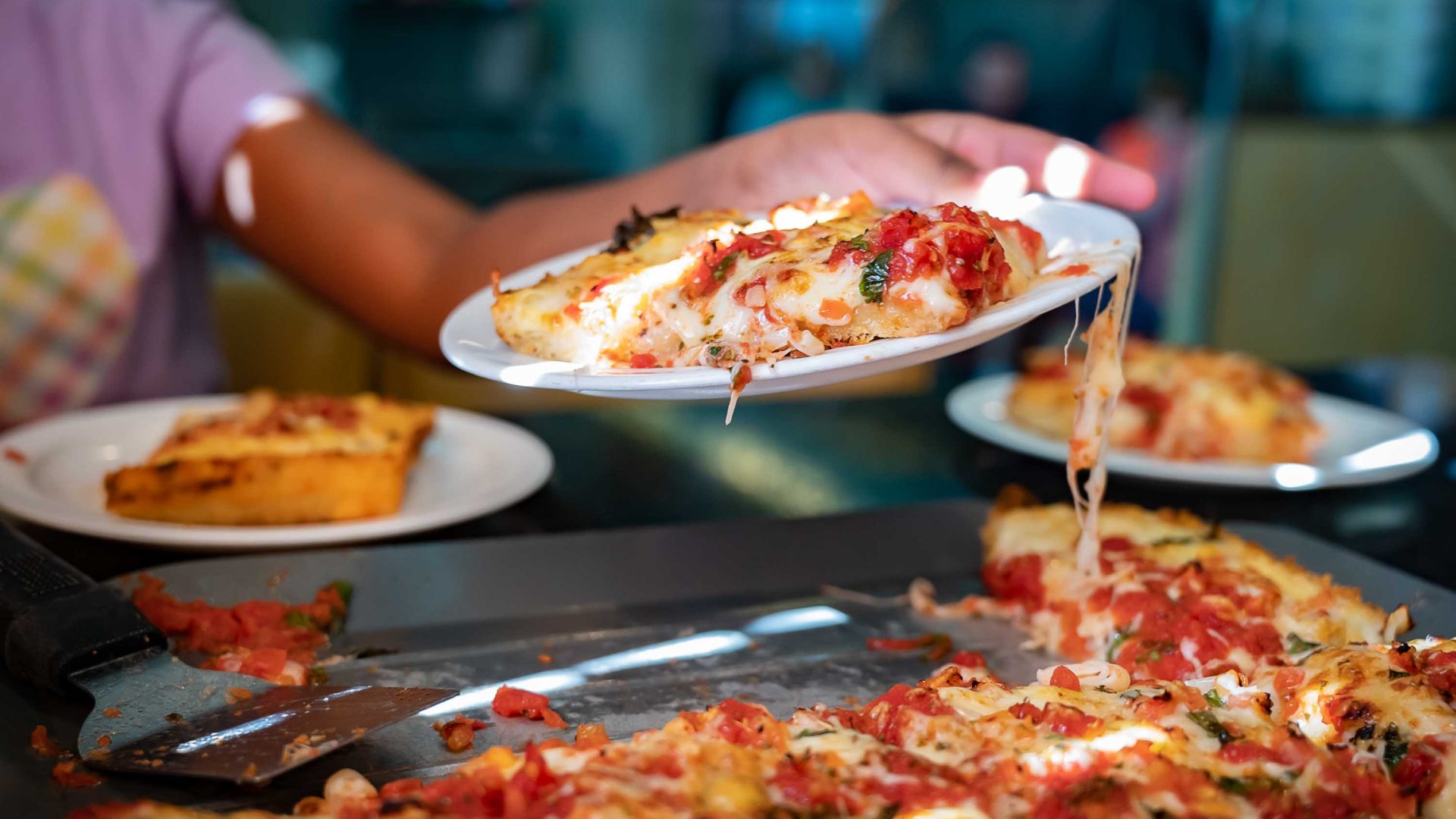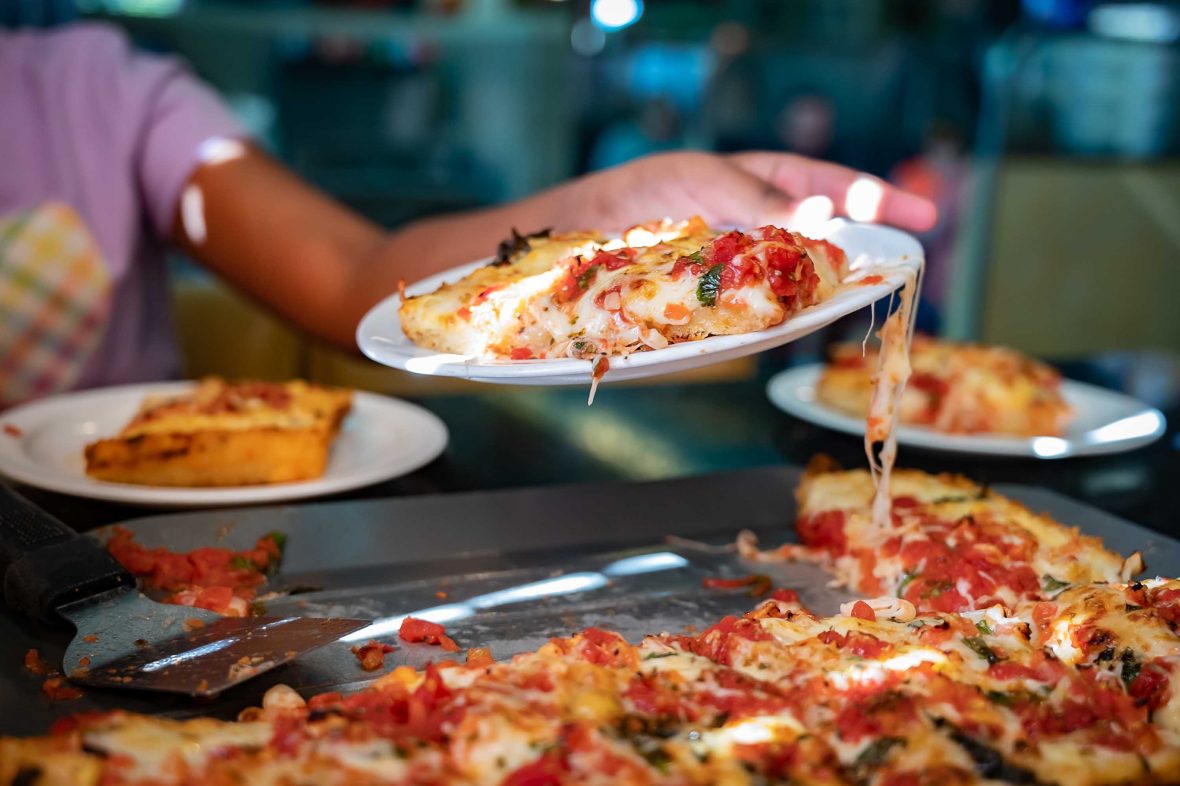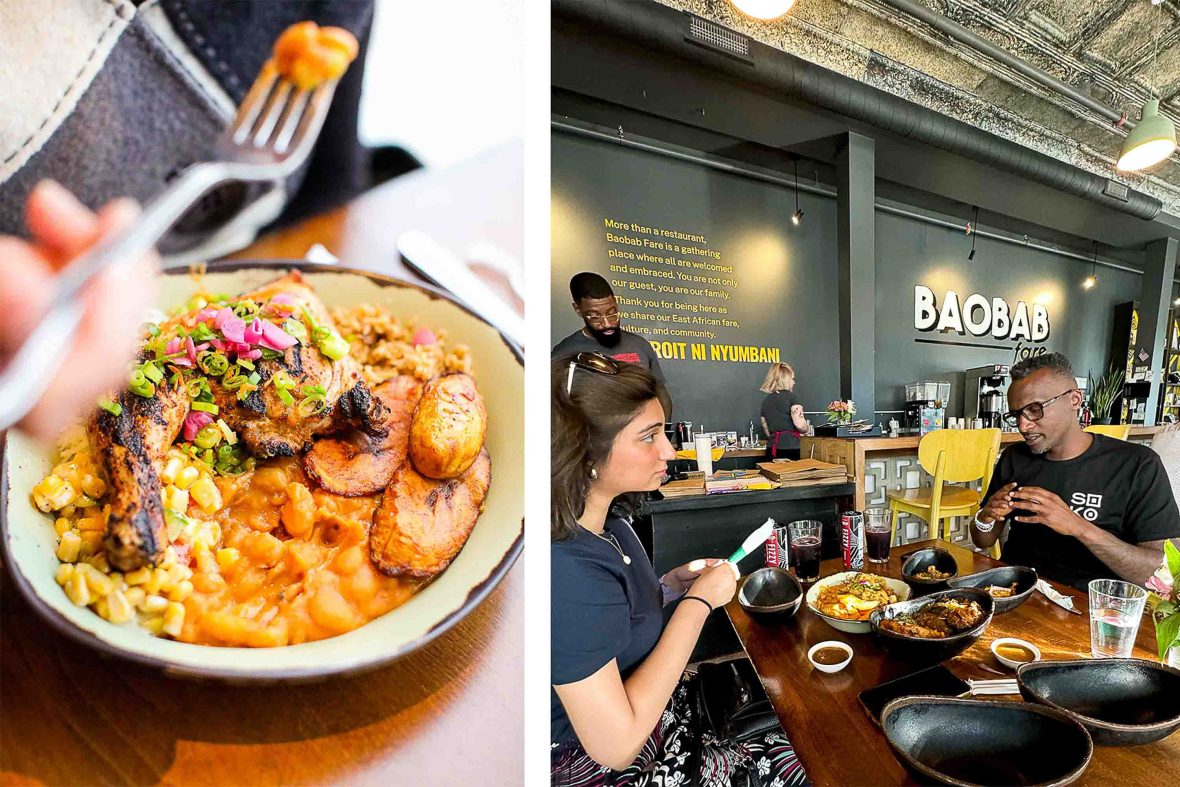
Chicago’s might be more famous and New York’s more iconic, but Detroit’s deep-dish pizza is more than just a tasty treat; its invention and evolution tell the story of Detroit from its industrial heritage to now.


Chicago’s might be more famous and New York’s more iconic, but Detroit’s deep-dish pizza is more than just a tasty treat; its invention and evolution tell the story of Detroit from its industrial heritage to now.
“What brings you to Detroit?” asks Desmon, the friendly receptionist at the David Whitney Hotel in Grand Circus Park, as he checks me in. Why are you going to Detroit? is a question I’ve already fielded. My answer is always a confident, “Why not?”
“I’m here to eat pizza,” I tell him, smiling at the array of pizza guides spread across the reception desk. Desmon’s eyes light up. “Ah, and just before Detroit Pizza Day! You’re in the right place then,” he says, handing me a map highlighting Buddy’s Pizza, the birthplace of Detroit-style deep dish pizza, conveniently located next door.
Detroit may have held something of a reputation of a rundown city in the past, but things have changed, and the string of freeways as I left the airport earlier hinted at connectivity and movement, not stagnation. As I passed through the inner-ring suburb of Dearborn, home to the Henry Ford complex and the birthplace of Detroit’s automotive legacy, the seemingly slick skyline of downtown Detroit loomed ahead, dominated by the Renaissance Center. And unknown to many visitors, Detroit-style pizza has garnered such local pride that it’s earned its own day—June 23rd—celebrated as National Detroit-style Pizza Day. And it happens to be while I’m here.
From my fifth-floor room, I have a perfect view of Buddy’s main branch. While Chicago often steals the limelight with its deep-dish pizza, Detroit has its own unique style rooted in the city’s industrial heritage.
But before I try my first slice, I head to the Henry Ford Museum of American Innovation. Situated within the vast Henry Ford complex, the museum takes visitors on an immersive journey through Detroit’s automotive history with artifacts, exhibits, and of course, original Ford cars. Next to the museum is Greenfield Village, where visitors can explore the childhood home and farm of Henry Ford himself.
“It’s a topic of contention among Detroit’s pizza purists as to who truly invented square pizza.”
- Nick Rye, manager at Buddy’s
Henry Ford may not have invented the automobile, but he revolutionized its production with the moving assembly line at his Highland Park plant in 1913. This innovation transformed industrial manufacturing worldwide, but it also changed Detroit. Workers from across the globe headed to the city for work opportunities, and one of those was Italian immigrant and Detroit deep-dish pizza ‘founder’ Agostino Guerra.
After World War II, Guerra purchased a small bar at Six Mile and Conant on Detroit’s eastside, and converted it into a pizzeria. It’s believed Guerra wanted to add an Italian touch to his menu, and so adapted his mother-in-law’s pizza recipe. But instead of a pizza tray, he baked it in the square blue steel trays originally used on Ford’s assembly lines, Wesley Pikula, Buddy’s chief brand officer, tells me. “As time went on, the cast iron and blue steel trays that Guerra used imparted a distinct flavor to the crust. It’s the same flavor that we still bring to the pizza today.”

Buddy’s is filled with pizza enthusiasts, families, and curious visitors enjoying trays of Detroit’s iconic pizza, and the vibe is buzzy. Next door, the Detroit Opera House reminds me of New York City (in fact, Detroit has the second-largest theater district in the US after Broadway) and outside, the Detroit People Mover—a 2.94-mile elevated automated people tram—whizzes past, ferrying [American] football pilgrims carrying leftover pizza boxes to Ford Field Stadium, a pilgrimage site even during the off-season.
“Various recipe developers, family members, cooks, and even suppliers from the assembly line went on to work at different pizzerias across the city,” says Nick Rye, manager at Buddy’s. “It’s a topic of contention among Detroit’s pizza purists as to who truly invented square pizza.”
So, what makes Detroit pizza so special? Buddy’s Detroit-style pizza is characterized by its square shape and light, airy, hydrated dough. Wisconsin brick cheese, (a traditional cheese produced in Wisconsin since the late 1800s), crisps perfectly along the sides of the pan, with toppings such as pepperoni, mushrooms, and green peppers layered before the cheese, followed by a tangy tomato sauce spread on top. It flips the traditional pizza order on its head, placing the toppings directly on the dough so their rich flavors soak into the crust.
I choose a four-square pizza with a slice of each vegetarian option available: Cheese, Greektown, Mediterranean, and Detroit Zoo. As a halalitarian, I’m not disappointed by the vegetarian options in the absence of halal meat, nor do generous American serving sizes prevent me from savoring the last of each slice. Between mouthfuls, I attempt to maintain coherent conversation, momentarily abandoning social etiquette. “Originally, Detroit deep-dish pizza was made with just cheese, but neighboring residents would bring vegetables from their gardens and ask Buddy’s to add them as toppings,” Nick explains.
This juxtaposition intrigues me: Food born in the dirt and grime of the city’s factories embracing ‘sustainability’—before sustainability even existed as a term—by incorporating locally grown vegetables as toppings.
Buddy’s Pizza still demonstrates this commitment to sustainability through initiatives such as Buddy’s Bones, where leftover multigrain pizza dough is repurposed into all-natural, veterinarian-approved dog treats. Buddy’s packages and sells these treats for USD$2 per pack, with proceeds going to the Michigan Humane Society, the state’s oldest and largest non-profit animal welfare organization.
Across the city, another pioneer in sustainable pizza-making is Detroit Pizza Bar, which has prevented approximately 7,500 pounds of carbon dioxide from being emitted since they opened in 2022. “Our goal is to serve one of the most sustainable pizzas in Detroit,” said Marcus Jones, co-owner of Detroit Pizza Bar.
It’s also my next stop. Located in the city’s Livernois-Six Mile neighborhood (Live6), Detroit Pizza Bar is the area’s first Black-owned sit-down restaurant in over three decades.
Baobab Fare is packed with a mix of locals and office workers grabbing a quick bite. I prop up at the bar, which serves coffee instead of alcohol. The restaurant is mostly vegetarian with halal options, and co-owner Hamissi Mamba is working to develop a fully halal, nutritious menu for Detroit’s elementary schools.
Jones and co-owner Akunna Olumba initially faced challenges securing funding amid pandemic-created labor shortages and supply chain disruptions, but Jones has kept true to the restaurant’s core principle of sustainability, influenced by his background in studying environmental science and urban planning at the University of Michigan.
Support from Michigan Saves and a USD$1.3 million loan from Detroit’s Strategic Neighborhood Fund eventually enabled them to realize their vision.This included installing 11 rooftop solar panels for energy offsetting, tankless water heaters, LED lighting, and a rainwater capture system for plant irrigation and flood prevention.
Jones emphasizes that sustainability isn’t a luxury but a necessity for the future, countering the traditional view of lenders. He highlights innovations such as passive solar thermal heating through south-facing windows, which effectively maintain warmth during cold weather without relying on the furnace. “Our cooking methods not only enhance the enjoyment of Detroit’s pizza, but also contribute to reducing our impact on climate change by promoting cleaner cooking practices,” he explains. It’s not just sustainable but also delicious, verified by the slice of vegan pepperoni I somehow find room for.

How a dish can tell so much about the city’s history is remarkable. I carry on my industrial heritage lesson at the Detroit Institute of Arts on Detroit’s main thoroughfare of Woodward Avenue. One of America’s largest art museums, it has 66,000 works of art, was the world’s first art institution to acquire a self-portrait by Van Gogh, and was recognized by USA Today as the top art museum in the US for 2024. But I’m here to see Diego Rivera’s iconic Detroit Industry Murals from 1932, which highlight both the benefits and costs of Detroit’s status as Motor City.
Rivera’s work beautifully captures the early 20th-century industrial landscape, representing the synergy between man and machine. And while the mural’s stars-and-steel motifs symbolize aspirations and hope, Rivera’s work also explores the dark side of industrial progress: Weaponized warfare, poor working conditions and increasing class stratification. It’s a reflection of Rivera’s deep admiration for the working class and his critical perspective on industrial capitalism.
Further along Woodward Avenue, numerous other restaurants champion sustainable food practices beyond Detroit-style deep dish pizza, but they also showcase the city’s diverse community, a legacy of its industrial golden age. Among them is Baobab Fare, an East African restaurant founded by Muslim refugees from Burundi. The restaurant was also a recent nominee for a coveted James Beard Award.
Baobab Fare is packed with a mix of locals and office workers grabbing a quick bite. I prop up at the bar, which serves coffee instead of alcohol. The halal restaurant has many vegetarian options, and co-owner Hamissi Mamba is working to develop a fully halal, nutritious menu for Detroit’s elementary schools. They’ve also created their own in-house Soko brand, with produce including Burundian coffee beans roasted and packaged in Detroit, bottled passion fruit juice, spicy Pili sauce, and handmade jewelry from Rwanda, sold worldwide.
“A few years ago, I couldn’t imagine being in a white kitchen as a Black Muslim refugee who believes in homegrown produce and refuses to serve pork and alcohol in his restaurant,” Mamba says, as he goes through the best menu items for me to try. “What would you like?” he asks me.
“Something other than pizza!” I reply.

Alongside his busy restaurant business with wife Nadia, Mamba helps to set the menu at the Henry Ford Museum’s restaurant one month a year, and recently, Baobab Fare launched single-origin chocolate bars made with Tanzanian cacao, under the brand name Shokola, an initiative which aims to cut out middlemen, ensure fair prices for farmers, and introduce Detroiters to the flavors of Burundi and other African nations.
After enjoying a delicious meal of intore—eggplant stew served with yellow beans, fried plantains and coconut rice—I say goodbye to Mamba and head back to downtown Detroit. As my taxi navigates the streets, the city’s QLine streetcar zips by. It aims to encourage less car dependence in the city, and corporate sponsorships allow the trams to run at no cost to passengers. An electric car approaches from the opposite direction while I pass a growing number of restaurants proudly displaying ‘fully vegetarian’ signs.
Reflecting on my journey through Detroit—from its delicious pizza to innovative initiatives—I am deeply moved by the city’s resilience and unwavering commitment to change. I understand now why Detroiters never gave up on their city, even during its darkest times. It wasn’t just a matter of capability, but a desire to persevere. Detroit has the infrastructure, energy, and respect for its heritage, evident in the renewal of once-abandoned buildings into public spaces full of life. As Mamba says, his choice to operate his restaurant in Detroit was driven not only by its people but also by its openness to fresh ideas, innovation, and a shared vision for a brighter future: “Detroit truly is home in more ways than one.”
The writer was hosted by Visit Detroit and Delta Air Lines on an all-inclusive press trip for this story, including flights and a hotel stay at the David Whitney Hotel, Autograph Collection.
***
Adventure.com strives to be a low-emissions travel publication. We are powered by, but editorially independent of, Intrepid Travel, the world’s largest travel B Corp, who help ensure Adventure.com maintains high standards of sustainability in our work and activities. You can visit our sustainability page or read our Contributor Impact Guidelines for more information.

Queenie is a British-Pakistani journalist specialising in travel, entertainment, and reinsurance journalism. Her articles often touch on the experiences of traveling as an ethnic minority individual and seeking unique, out-of-the-box experiences. Intrigued by unconventional spots and diverse customs, her wanderlust has led her to over 70 countries.








Can't find what you're looking for? Try using these tags: